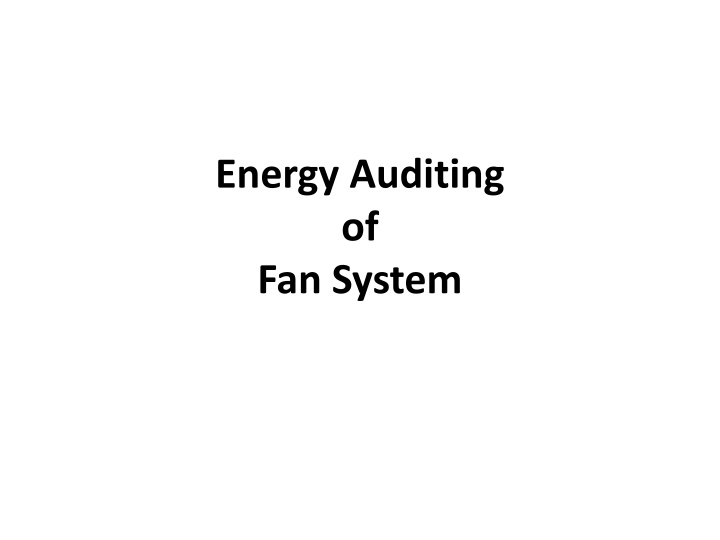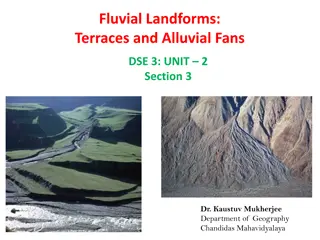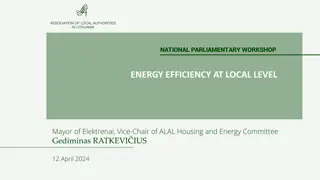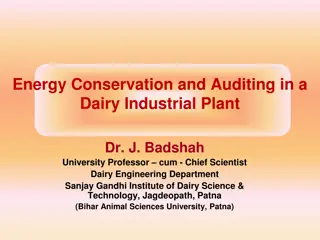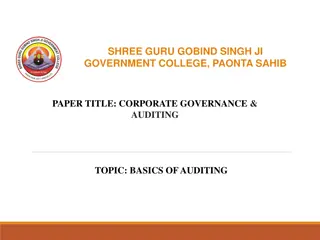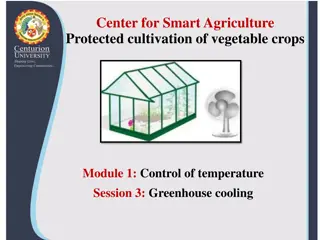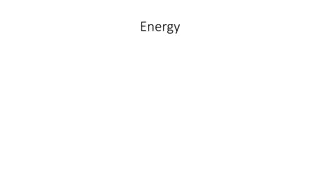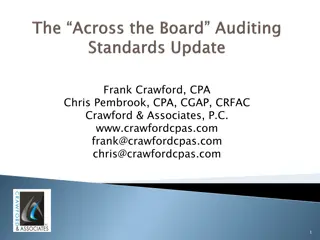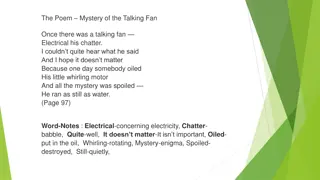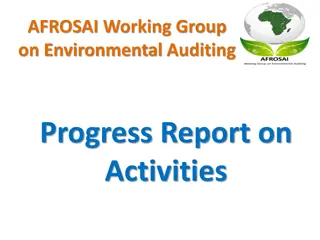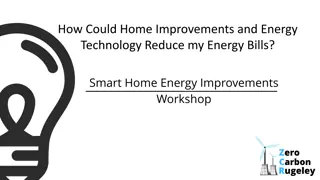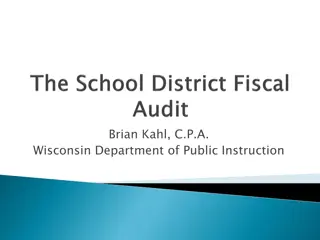Energy Auditing of Fan System
Evaluating and optimizing the performance of a fan system are critical steps in maximizing energy efficiency. This process involves assessing the operation of various components, identifying inefficiencies, and recommending energy-saving solutions. Conducting an energy audit for a fan system helps to reduce energy consumption, lower operational costs, and enhance overall system performance. By analyzing key factors such as airflow, motor efficiency, and system controls, energy auditing plays a vital role in improving sustainability and reducing environmental impact.
Download Presentation

Please find below an Image/Link to download the presentation.
The content on the website is provided AS IS for your information and personal use only. It may not be sold, licensed, or shared on other websites without obtaining consent from the author.If you encounter any issues during the download, it is possible that the publisher has removed the file from their server.
You are allowed to download the files provided on this website for personal or commercial use, subject to the condition that they are used lawfully. All files are the property of their respective owners.
The content on the website is provided AS IS for your information and personal use only. It may not be sold, licensed, or shared on other websites without obtaining consent from the author.
E N D
Presentation Transcript
Energy Auditing of Fan System
Centrifugal Fan Applications Supplying combustion air Discharging flue gases Transporting materials Ventilating buildings
Fan Types Centrifugal fans Axial fans
Flow in Centrifugal fan Flow in Axial fan
Centrifugal -Forward Curved Blades curved in the direction of rotation Low efficiency (between 50 65%) Small and compact Lower airflow, lower static pressure, lower first cost Clean air HVAC applications-
Centrifugal-Radial Bladed Flat blade shape Applications requiring low to medium airflow rates at high pressures High dust level applications- Pneumatic conveying
Centrifugal-Radial-tip Less turbulence than radial bladed More efficient than the radial blade but less than backward inclined (up to 75%) Airstreams containing small amount of dust
Centrifugal-Backward Curved Blades curve tilt away from direction of rotation Higher speed than Forward curved fans Most efficient fan (65-75%) Higher airflow, higher static pressure, higher efficiency Large HVAC applications
Centrifugal-Backward Inclined(Airfoil) Smooth air flow across bade surface reducing turbulence Higher static efficiency (exceeding 85%) Clean air applications e.g. forced-draft fans(boilers) and industrial dryer fans (furnaces)
Axial Fan Types Propeller Fan Tube-axial Fan 70-80% efficiency Vane-axial Fan
Features of Axial Fans Compactness Light weight Low cost Direct-drive units (operating at motor speed) Belt-drive units (flexibility in fan speed selection) Offers better efficiencies over wider range of duties
Applications of axial fans Exhausting contaminated air or supplying fresh air Unidirectional or reversible air-flow applications Exhaust applications where airborne dust size is small, such as dust streams, smoke and steam
Fan Selection Airflow Static pressure Temperature Dust Moisture System layout Cost Availability Plant personnel familiarity
Estimation of Airflow & Static Pressure Airflow estimated based on user requirements Static pressure estimated based on pressure drops in various components: Pipe size, length, bends, filter, equipment (e.g. waste heat recovery devise), etc. in the air flow path.
Static, Velocity and Total Pressures Static Pressure Static pressure is the pressure exerted on the duct walls. Velocity Pressure Velocity pressure is the kinetic energy of a unit of air flow in an air stream. It is also called as dynamic pressure. The velocity pressure depends upon both air velocity and density. Total Pressure Total pressure consists of sum of pressure the moving air exerts in the direction of flow (velocity pressure) and the pressure air exerts perpendicular to the air flow in the duct (static pressure).
Relationship between Velocity, total and Static Pressures PV = PT - PS Where, PV = Velocity Pressure PT = Total Pressure PS = Static Pressure If velocity pressure is measured, velocity can be calculated and air flow can be determined.
Static Efficiency Static efficiency Static efficiency considers only the flow delivered against the static pressure. e.g., the larger the diameter of fan selected, lower will be the velocity pressure with consequently lower wasted power, and higher fan static efficiency.
Calculation of Velocity and Flow rate Average velocity = V1 + V2+ VN Total number of traverse points Where VN is the velocity at the Nth traverse point Airflow (Q), m3/s = Average velocity, V (m/s) x Fan duct area (m2) Measure flow at various operating conditions and not one flow
Fan Shaft Power Fan Shaft Power, kW or Fan Break Horse Power (BHP) = Fan motor power, kW x Motor Efficiency, m
Fan Efficiency-Total & Static Fan Static Efficiency static, % = Airflow in m3/s x P (Static Pressure) in mmWC 102 x Fan Shaft Power in kW P (Static Pressure) = Discharge Static Pressure Suction Static Pressure
Fan System Curve Sum of all system components: Ductwork Elbows Transitions Filters Coils Dampers / Louvers Building pressure Ps = k * CFM2 Pressure Increases with the Square of CFM!
Flow Control Discharge Damper Throttles the air entering or leaving the fan Control airflows in branch ducts of a fan system, or at points of delivery Creates restriction airflow- cause pressure drop and waste energy More pressure drop less flow in
Outlet dampers have a relatively small effect on input power
Flow Control VFD Close match between the fluid energy required by system and delivered by the fan Uses electronic controls to regulate motor which in turn adjusts the fan speed to meet the demand VFD controls the frequency of the power supplied to the motor to establish its operating speed. energy speed
VFD Application Data and Information Flow and pressure requirements of the system in relation to the main business driver (e.g. production). Fan type, make, flow rate, pressure, rated efficiency, motor rating in kW, motor efficiency, control method, drive system, pulley diameters (fan & motor) if applicable. Production run-hours and system demand over the full range of plant operating conditions. Other inter-related information depending upon the application (say AHU specifications, heat exchangers, driers, cooling tower capacities, combustion air requirements for boilers).
Fan Replacement Fans normally oversized during design Oversized fans deviate far from BEP Oversized fan generate higher pressure for the same flow Visual signs of over sizing Almost closed dampers and inlet guide vanes Study if entire fan-motor can be replaced OR atleast fan can be replaced
ENCON Opportunities in Fan Systems Operational and Housekeeping Measures Turn off fan when it is not needed Check and adjust belt tension (motor-fan) regularly. Arrest any leaks in the duct. Clean fan blades regularly.
ENCON Opportunities in Fan Systems Low-Cost Measures Avoid damper operation through speed control (motor/fan pulley change). Consider impeller change where applicable for fixed flow applications. Explore use of low-slip belts such as flat, cogged belts. Improve fan inlet and outlet duct connections to ensure proper flow distribution and losses at the inlet and outlet.
ENCON Opportunities in Fan Systems Retrofit Measures Avoid damper operation through VFD - reducing a fan s speed by 20% can reduce its power requirements by nearly 50%. Replacing existing fan with energy efficient fan operating closer to BEP. Review and increase duct size if feasible. A 15% increase in duct diameter can reduce pressure drop by 50%. This allows smaller fan motor to be used. Reduce bends in the ductwork. Replace fan motor with energy efficient motor. Use energy efficient aerofoil backward curved fans if feasible.
